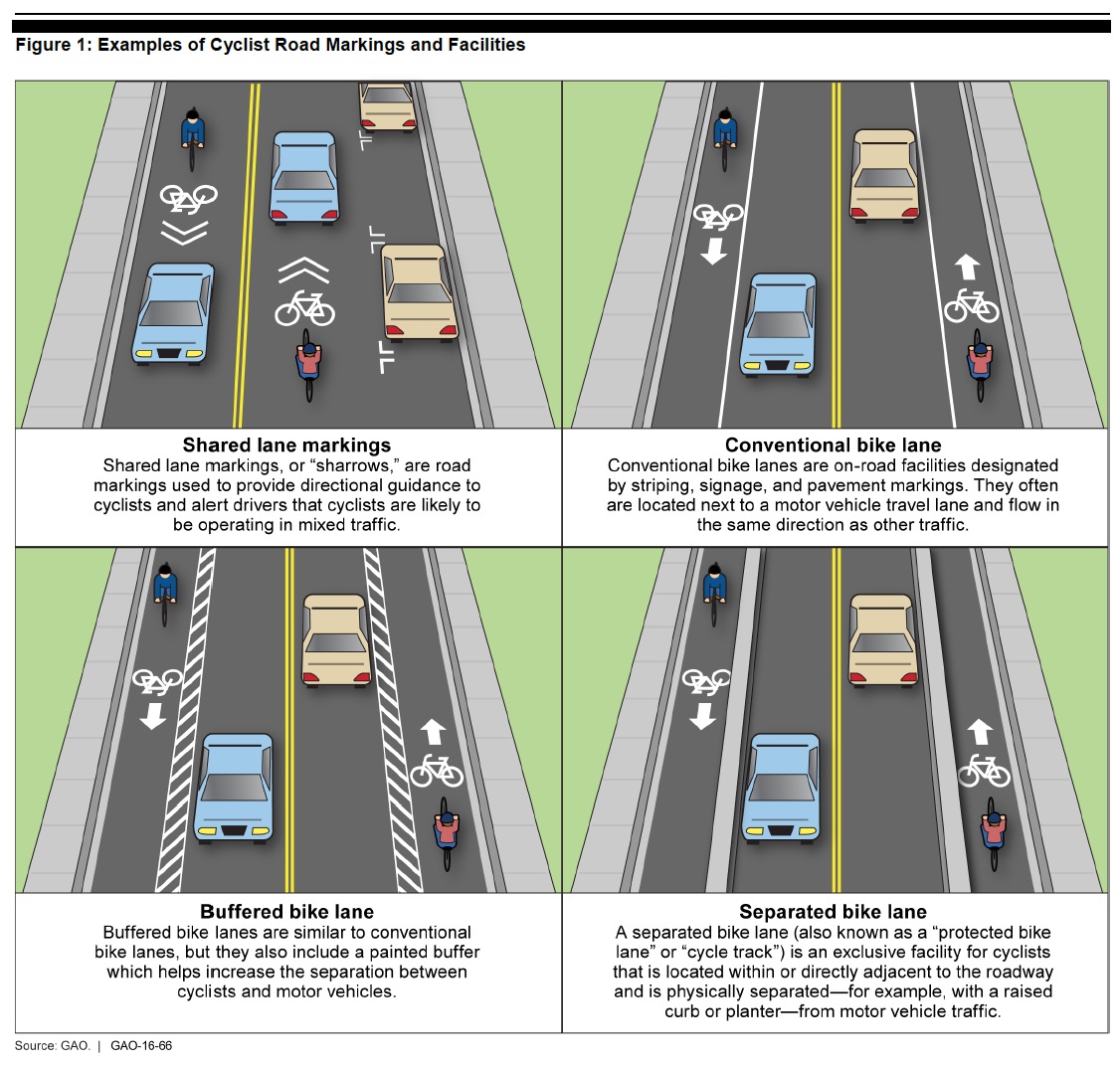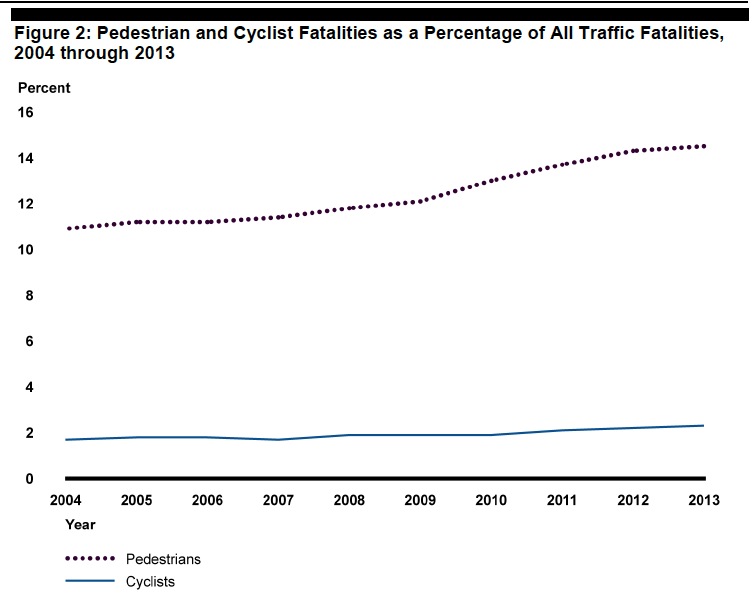UNITED STATES GOVERNMENT ACCOUNTABILITY OFFICE
Why GAO Did This Study
 Walking and biking are becoming increasingly popular modes of transportation: nearly a million more people reported walking or biking to work in 2013 than in 2005. While total traffic fatalities declined from 2004 through 2013 (the most recent year for which data are available), this was not matched by a similar decline in pedestrian and cyclist fatalities. GAO was asked to review pedestrian and cyclist safety data and challenges in addressing this issue. This report examines: (1) trends in pedestrian and cyclist fatalities and injuries from 2004 through 2013 and characteristics of these fatalities and injuries; (2) safety initiatives selected states and cities have implemented and their views on challenges in addressing this issue; and (3) actions taken by DOT to help improve safety.
Walking and biking are becoming increasingly popular modes of transportation: nearly a million more people reported walking or biking to work in 2013 than in 2005. While total traffic fatalities declined from 2004 through 2013 (the most recent year for which data are available), this was not matched by a similar decline in pedestrian and cyclist fatalities. GAO was asked to review pedestrian and cyclist safety data and challenges in addressing this issue. This report examines: (1) trends in pedestrian and cyclist fatalities and injuries from 2004 through 2013 and characteristics of these fatalities and injuries; (2) safety initiatives selected states and cities have implemented and their views on challenges in addressing this issue; and (3) actions taken by DOT to help improve safety.
GAO analyzed DOT data on pedestrian and cyclist fatalities and injuries from 2004 through 2013. GAO also reviewed relevant documents and reports, and interviewed officials from DOT; three states (California, Florida, New York); the District of Columbia; six cities (Austin, Texas; Jacksonville, Florida; Minneapolis, Minnesota; New York City, New York; Portland, Oregon; San Francisco, California); and 22 non-governmental organizations with an interest in pedestrian and cyclist safety. States and cities were selected based on number of fatalities, walking and cycling activity, and recommendations from non-governmental organizations. Non-governmental organizations were selected to reflect a range of expertise. DOT reviewed a draft of this report and provided a technical comment, which was incorporated.
What GAO Found
Pedestrian and cyclist fatalities and injuries represent a growing percentage of all traffic fatalities and injuries. For example, pedestrian fatalities comprised 10.9 percent of all traffic deaths nationwide in 2004, but 14.5 percent in 2013. Cyclists represented 1.7 percent of all United States traffic deaths in 2004, but 2.3 percent in 2013. Estimates of pedestrian and cyclist injuries also grew during this same time frame. In 2013, most traffic crashes that resulted in a pedestrian’s or cyclist’s death involved men, occurred in urban areas, happened in clear weather conditions, and most frequently took place between 6:00 p.m. and 9:00 p.m. Various factors—working separately or in combination—may have contributed to these fatalities and injuries, including increased walking and cycling trips; alcohol use; distracted road users; or road design practices.
Officials from states and cities in GAO’s review reported that they have implemented a number of efforts, but face challenges in addressing pedestrian and cyclist safety. For example, states and cities reported collecting and analyzing data on walking and cycling activity and crashes to develop safety efforts. Officials said that a variety of engineering standards have been used to design more walking or cycling facilities, such as sidewalks or bike lanes. State and city officials also reported implementing education and enforcement initiatives. In addition, three jurisdictions reported that they implemented Vision Zero programs, which are comprehensive initiatives to integrate data collection, engineering, education, and enforcement actions. However, state and city officials GAO interviewed most often cited challenges with prioritization, data, engineering, and funding in addressing pedestrian and cyclist safety. Prioritizing safety in this area can be difficult according to officials because of, for example, differing state and city perspectives on transportation investments. Limited or no walking and cycling trip data or incomplete and unreliable crash data also hinder efforts, according to many officials. Problems with existing roadways, such as wide lanes that may encourage drivers to speed and limited pedestrian and cyclist facilities, were also indicated as safety challenges. Officials also noted that funding issues can limit the ability to address pedestrian and cyclist safety. These challenges may be interrelated: according to some officials, limited data on walking and cycling trips can hinder the development of a performance-based approach, which could assist jurisdictions in prioritizing pedestrian and cycling safety.
The U.S. Department of Transportation (DOT) has implemented and is planning to take further actions to help improve pedestrian and cyclist safety. For example, the Mayors’ Challenge—part of DOT’s Safer People, Safer Streets initiative—encourages officials to prioritize pedestrian and cyclist safety. On data collection, DOT is leading a pilot project on trip-counting technologies and updating guidance for states on data to include in crash reports. On engineering efforts, DOT issued a memorandum supporting flexibility in the design of pedestrian and cyclist facilities, as well as guidance to help reduce motorist speed. DOT oversees 13 funding programs that can award funds—$676.1 million in 2013—to be used toward pedestrian and cyclist safety. Given the increase in walking and cycling activity and the percentage of pedestrian and cyclist fatalities and injuries, it will be important that efforts such as these continue.
About the United States Government Accountability Office
www.gao.gov
The U.S. Government Accountability Office (GAO) is an independent, nonpartisan agency that works for Congress. Often called the “congressional watchdog,” GAO investigates how the federal government spends taxpayer dollars.
Tags: Bicycling, Cycling, Pedestrian, safety, U.S. GAO, United Staes Government Accountability Office







 RSS Feed
RSS Feed